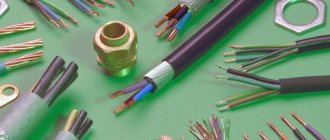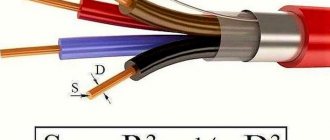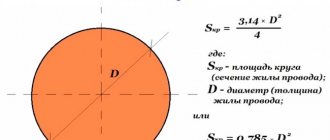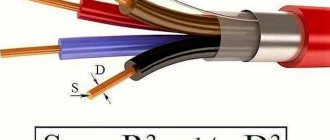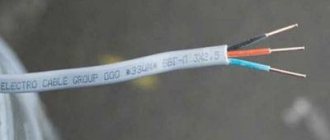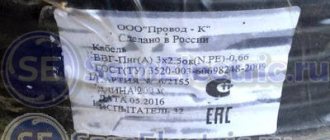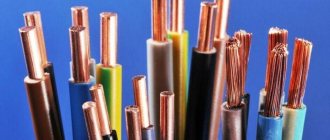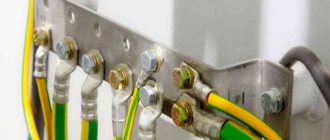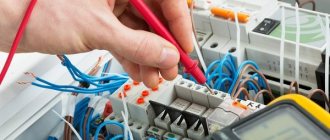The quality of the cable during wiring installation is the most important component of success. High-quality wires are produced in accordance with GOST, but there are also products produced according to specifications with less strict control. In any case, it would be a good idea to check the cable parameters manually. After all, consumer complaints about underestimation of the cross-section of the copper core are quite common. It is important to check the integrity of the chosen manufacturer: does the declared cross-section correspond to the real one? If you need to compare wire gauge and diameter, the table will help you do it quickly and easily. Look for the sign at the end of the article.
Experts say that if you buy a non-GOST cable, the savings on copper conductor can range from 10% to 40% of the declared nominal value. If you take an unscrupulous manufacturer's word for it, this could cost you serious damage - from shortening the service life of wiring to fire and failure of expensive equipment.
Be sure to ask the seller for a certificate for cable products. Check the labeling on the insulation, not just the tag and box. You should also look for the name of the manufacturer on the shell.
In accordance with the requirements of GOST 31996-2012, the space between the insulated conductors must be filled. Therefore, even a visual inspection of the cable cut will let you understand how responsible the manufacturer is about standards.
To determine the cross-section of a wire by diameter, you must first measure this same diameter.
How to measure core diameter with a micrometer
There are several methods for measuring the diameter of a wire or cable core:
- Micrometer;
- Vernier caliper;
- With a ruler.
These methods are listed in order of accuracy. The micrometer allows you to determine linear dimensions with an accuracy of 0.2 microns. Smooth, wire, thread and digital micrometers are suitable for working with wiring. Below you will see a photo and the main parts of a micrometer for measuring cable cores.
1 — support stand for fixing the conductor;
2 - screw;
3 - fixed nut for measurements;
4 - fixed stem with scale;
5 - measuring drum;
6 - ratchet.
How to determine the cross-section of a wire using a micrometer ? First of all, we always measure the diameter of the core, and the measurement principle is quite simple. First, the accuracy of the device is checked by tightening the screw and simply checking whether the zero of the drum scale coincides with the horizontal line on the stem. In cases where the marks do not match, the meter adjusts the stem using a special key from the micrometer kit. Next, we proceed to the preparatory stage - unscrew the screw to a size greater than the diameter of the wire. We place the core, stripped of insulation, in the gap between the fixed stop and the screw. We clamp the screw with a ratchet, listen to the number of clicks: the screw should stop tightening after three clicks. Next, we must take readings on three scales: on the stem and on the drum. The bars at the top of the scale show the full number of millimeters, half of the second scale is another half a millimeter. Finally, we add the reading from the drum scale to our records, carefully consider the value of the scale division (usually 0.01 mm), and then sum all three indicators to obtain the result.
Ideally, you need to take several measurements of the wire diameter using a micrometer and calculate the arithmetic average.
Subscribe to the newsletter
When a multi-core cable is used that does not meet the declared characteristics and is not manufactured in accordance with GOST, undesirable consequences may occur. Moreover, you can find cables on sale whose labeling and packaging contain unreliable indicators. The declared cross-section may not correspond to the true figure. It turns out that the core of the cable, purchased taking into account a specific load, cannot cope with the current that it should pass. As a result, the insulation melts. The risk of an emergency, including a short circuit, increases significantly. To prevent this from happening, you need to know how to determine the cross-section of a multi-core cable.
Read also: Crafts using a glue gun
Features of calculating the cross-section of a single-wire (monolithic) core
So, you purchased a cable with a single-wire core and decided to measure its cross-section. To make this possible, you first need to acquire a caliper, a calculator, an insulation stripper and a utility knife. Set the cross-section to the cable diameter. To do this, do the following:
• Strip the insulation from the cable. • Measure the core diameter (using a caliper). • Remember school geometry, namely the formula that allows you to calculate the area of a circle (circular conductive core):
S = π r2, where π = 3.14 and r is the radius of the core.
Thanks to a caliper, you can only find out the diameter, but what is required is the radius. The formula should be modified. It is known that the radius is half the diameter. The formula will look like this:
S = (π d2)/4, where d is the diameter of the core.
To shorten the formula, you can divide the number π by 4. You will get a standard formula for calculating the cross-section of the core by diameter:
Let us carry out the calculation using the example of the VVG-P 2x1.5 cable, in which the diameter of the cores when measured with a caliper is 1.35 mm. Substitute the value into the formula:
S = 0.785*1.352 = 1.43 mm²
From the calculations it is clear that the actual cross-section of the core is 4.7% less than the declared one, which is an acceptable underestimation.
As practice shows, it is not difficult to calculate a single-wire conductor. The main thing is to be careful and not confuse the diameter with the radius and vice versa.
Subtleties of calculating the cross-section of a stranded conductor
Not all cables have solid cores, and in such cases the question arises: how to determine the cross-section of a multi-core cable with stranded cores?
Awareness of how to measure the cross-section of a multi-core cable will allow you to be confident in the safety and reliability of using the product. Here, too, everything is extremely clear. The cross-sectional area of a multi-core cable with stranded cores must be measured based on the area of one wire of the cores. Proceed in the following order:
1. Take the cable and remove the sheath and insulation from one of the cores. 2. Fluff the core and count all the wires. 3. Measure the diameter of one of the wires that makes up the core. 4. Use the above formula to calculate the single-wire conductor. This will allow you to find out the area of one wire. 5. Multiply the resulting value by the total number of cores.
For example, you have a cable KGVVng(A) 5x1.5. Having stripped, fluffed the core, measured one of the wires with a micrometer, and also counted the number of wires, we obtain the following data:
• Number of wires - 28 pcs. • Diameter of one wire - 0.26 mm
First, let's calculate the cross-section of one wire:
S = 0.785*0.262 = 0.053 mm²
Now the obtained value must be multiplied by the number of wires in the core - and we get a cross-section of 1.378 mm²
However, when calculating the cross-section of stranded conductors, it is also necessary to take into account the wire twist factor, which will be equal to 1.053 for cables with stranded conductors of class 5. As a result, we obtain a conductor cross-section equal to 1.45 mm² - the actual cross-section of the conductor is also less than the declared one by 3.3%, which is acceptable.
Anyone can calculate the cross-section of a single-core and multi-core cable. To do this, you just need to use the above formulas. Knowing how to measure the cross-section of a multi-core cable, you will be able to choose the right product, and in the end there will be no problems. Therefore, before carrying out any manipulations related to the use of a cable, be sure to make this calculation.
is one of the leaders in the sale of cable products and has warehouses located in almost all regions of the Russian Federation. After consulting with the company’s specialists, you can purchase the brand of multi-core cable you need at competitive prices.
Each of us has gone through renovations at least once in our lives. During the repair process, it is necessary to install and replace electrical wiring, because it becomes unusable after prolonged use. Unfortunately, on the market today you can find a lot of low-quality cable and wire products. Due to various methods of reducing the price of a product, its quality suffers. Manufacturers underestimate the insulation thickness and cable cross-section during the production process.
One way to reduce the cost is to use low-quality materials for the manufacture of the conductive core. Some manufacturers add cheap additives when making wires. Due to this, the conductivity of the wire is reduced, and, therefore, the quality of the product leaves much to be desired.
In addition, the declared characteristics of the wires (cables) are reduced due to the reduced cross-section. All the manufacturer’s tricks lead to more and more low-quality products appearing on sale. Therefore, you should give preference to those cable products that have quality confirmation in the form of certificates.
The price of a high-quality cable is the only, and perhaps the main, drawback that negates a lot of the advantages of this product. A copper cable and conductor product, which is produced in accordance with GOST, has the declared cross-section of the conductor, the composition and thickness of the sheath and copper core required by GOST, is produced in compliance with all technologies, and will cost more than those products that were produced in artisanal conditions. As a rule, in the latter option you can find a lot of shortcomings: a reduced cross-section by 1.3-1.5 times, imparting color to the cores due to steel with the addition of copper.
Buyers rely on price when choosing a product. The main focus is on finding a low price. And many of us can’t even name the manufacturer, let alone the quality of the cable. It is more important to us that we found a cable with the required marking, for example, VVGp3x1.5, but we are not interested in the quality of the product.
Therefore, in order to avoid getting into trouble, in this article we will consider several ways to determine the cross-section of a cable based on the diameter of the core . In today's tutorial I will show how such calculations can be made both with and without the help of high-precision measuring instruments.
Read also: Formula for calculating electricity consumption
What to do without a micrometer and calipers
For the sake of several measurements, it is not at all necessary to buy a micrometer or caliper. There is a well-known “old-fashioned” method for determining the diameter of a wire using a ruler, and you already know how to find out the cross-section of a wire using the formula.
So, you need to strip the insulation from the core and wrap it tightly around a pencil (see picture).
And then you simply apply a ruler to the winding, measure the total length of the wound conductor and divide it by the number of turns. It is convenient to count the number of turns in 1 or 2 cm.
The greater the number of turns, the higher the measurement accuracy. Wind at least 15 turns for good results.
The formula for wire diameter using this method looks like this:
D = l/n,
in which l is the length of all turns, and n is the number of wound turns.
Some useful tips for this method:
- minimize the gaps to reduce the error, that is, wind the core closely.
- get as many results as possible and calculate the arithmetic mean, this will also reduce measurement error.
- check the flexibility of the wire before winding - this method is suitable for relatively thin conductors.
See how to find out the cable cross-section by the diameter measured with a ruler.
General information about cable and wire
When working with conductors, it is necessary to understand their designation. There are wires and cables that differ from each other in their internal structure and technical characteristics. However, many people often confuse these concepts.
A wire is a conductor that has in its design one wire or a group of wires woven together and a thin common insulating layer. A cable is a core or a group of cores that has both its own insulation and a common insulating layer (sheath).
Each type of conductor will have its own methods for determining cross sections, which are almost similar.
Conductor materials
The amount of energy that a conductor transmits depends on a number of factors, the main one of which is the material of the current-carrying conductors. The following non-ferrous metals can be used as the core material of wires and cables:
- Aluminum. Cheap and lightweight conductors, which is their advantage. They are characterized by such negative qualities as low electrical conductivity, a tendency to mechanical damage, high transient electrical resistance of oxidized surfaces;
- Copper. The most popular conductors, which have a high cost compared to other options. However, they are characterized by low electrical and transition resistance at the contacts, fairly high elasticity and strength, and ease of soldering and welding;
- Aluminum copper. Cable products with aluminum cores coated with copper. They are characterized by slightly lower electrical conductivity than their copper counterparts. They are also characterized by lightness, average resistance and relative cheapness.
Various types of cables according to core material
Important! Some methods for determining the cross-section of cables and wires will depend specifically on the material of their conductor component, which directly affects the throughput power and current strength (method of determining the cross-section of conductors by power and current).
Table of wire cross-sections by diameter
The theory must be known and understood, but still, to save time, it is advisable to use a ready-made table of wire cross-sections by diameter. It can also be used to find the cross-sectional diameter of a wire.
As you can see, the cable diameter cross-section in the table corresponds to similar calculations using the formula.
How to find out the cable cross-section by power and current
Well, if the current-carrying capacity of the conductors is known, then determining their diameter is also easy using the table. Here you just need to substitute the maximum load current of the wire and find out its cross-section from the table below.
Things are a little different with determining the cross-section of stranded wires. Here, to obtain a more accurate result, you need to add together the area of each conductor.
